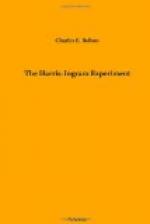May was about his own age. As Alfonso helped her down the gangway to the deck, he thought he had never seen her look so pretty. She was about the size of his sister Lucille; slender, erect, and in her movements she was as graceful as the swaying willows. May’s face was oval like that of her English mother. She had an abundance of brown hair, her eyes were brilliant, and her complexion, bronzed by the sea-breezes, had a pink under-coloring that increased her beauty. If Alfonso’s eyes were fixed on her a moment longer than custom allows, perhaps he was excusable, for portrait painting was his hobby, and he fancied that he knew a beautiful face.
Alfonso was all attention to his friends in clearing the baggage through the customs and getting checks for Leamington. After lunch, at the fine railway hotel, the two o’clock express from Lime Street station was taken, and Colonel Harris and party became loud in their praises of John Bull’s Island, as they sped on, via Coventry with her three tall spires, to the fashionable Spa, where the Harris family were again to be reunited. It was six o’clock when Alfonso alighted on the platform. “Here they are, mother, I have brought them all; father, Gertrude, George, and May.”
The Leamington meeting was a happy one. The sorrow of separation is often compensated by the joys of reunion. Mrs. Harris embraced her husband as if he had returned a hero from the wars. In fact, he had emerged from a conflict that brought neither peace nor honor to capital or labor.
Lucille too was enthusiastic. She, who was haughty, rarely responsive, and often proud of her father’s wealth, for the time assumed another character and warmly welcomed her sister Gertrude and Gertrude’s intended husband as “brother George.” Leo too was glad to make new acquaintances. Eight joyous people attracted the attention of many at the station.
Fortunately, the next day was Sunday, which gave time for rest, for review of the past few exciting weeks, and for the development of future plans of travel. Much was told of the Harris trip through Ireland and of the last week spent in the south of England.
Lucille described to Gertrude and May Stonehenge, hanging stones,—the wonder of Salisbury Plain, where stand the ruins of the Druid temple—three circles of upright moss-grown stones with flat slabs across their tops, in which it is supposed the sun was worshiped with human sacrifices. Many burial mounds are scattered about. A broad driveway, a mile in extent, surrounds the temple, where possibly great processions came to witness the gorgeous displays. In early Britain the Druid priests held absolute sway over the destinies of souls. These priests were finally overpowered by the Romans, and some of them burned upon their own altars.
“But, Lucille, you wrote that you planned to visit Osborne House.”
“Yes, dear, we did go to the Isle of Wight, and saw Osborne House, Queen Victoria’s home by the sea, as Balmoral is her summer home among the mountains of Scotland. Her Majesty’s palace is surrounded by terraced gardens, nearly five thousand acres of forests, pastures, and fertile meadows. Osborne House is furnished with much magnificence, mosaic flooring, costly marbles, statuary, paintings, books, and art souvenirs.




